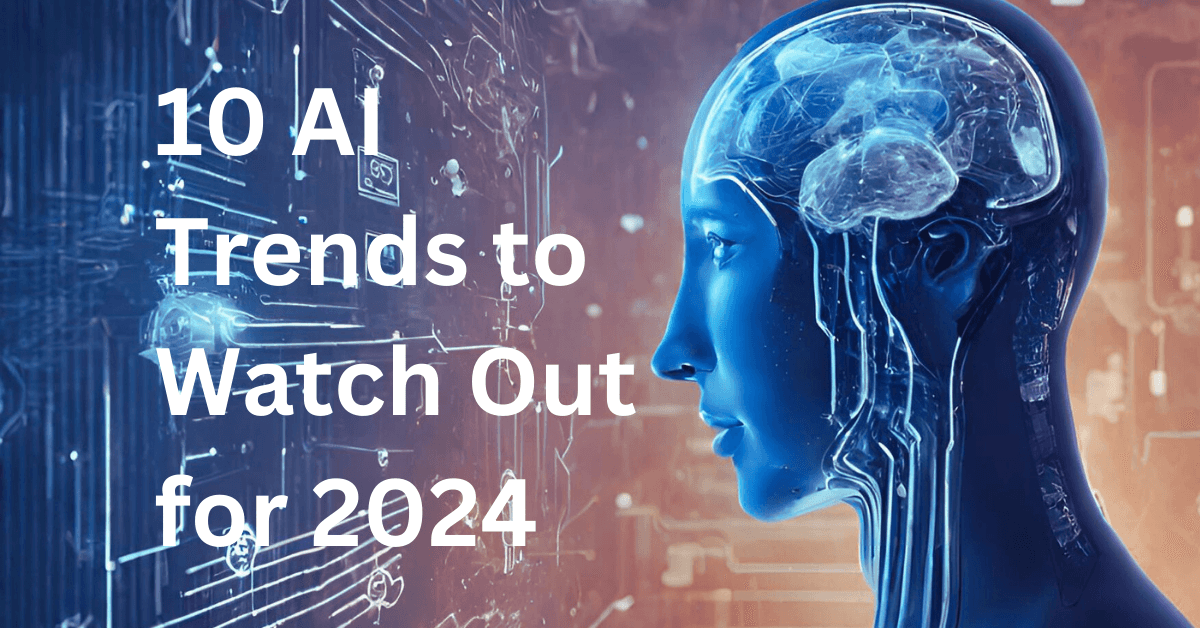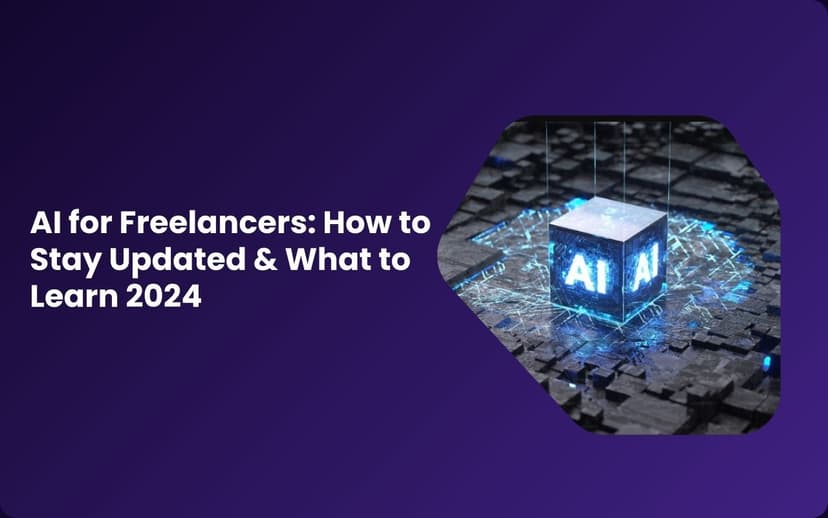
10 AI Trends To Watch Out For in 2024
The future is here! Artificial intelligence is to stay and continue to surprise us. But what AI trends do you need to know this year? Read here today!
Creating compelling, fun, entertaining, and informative content is easier than ever.
Projects and activities have lightning-quick turnaround times.
Workforce across industries is getting more productive.
Businesses are beginning to realize their full potential without denting the marketing and operational budgets while maximizing their bottom line.
These are just some benefits of 21st-century generative artificial intelligence.
Although the world was insecure about AI’s perceived threat to encroach on human activities, attitudes are maturing and becoming more nuanced.
Organizations shift from AI experimentation to real-world applications.
Today, we’re sharing what we know about the latest AI trends to watch out for this year.
Top 10 AI Trends in 2024
The following are the most recent artificial intelligence trends you should know.
1. Multimodal AI
In its infancy, AI relied solely on text-based prompts to generate content. Not anymore!
Today, AI processes data from multiple sources, including sound and images. That’s a step forward in mimicking human brain processes, giving credence to machine learning.
For example, Puppetry’s AI-powered Animator empowers content creators to generate AI videos with text or audio.
You could dictate the words the AI puppet will say in the video or copy and paste a video script into the script box.
And if you need help with what the puppet will say, its ChatGPT integration should make scriptwriting a breeze.
2. Powerful Virtual/AI Customer Agents
Virtual agents continue to wow customers and enhance their experiences while accelerating organizational communications, collaboration, and support.
Workplace efficiency is at an all-time high and will only grow this year.
Experts say seven in ten people will interact with powerful AI customer service agents and other virtual company representatives this year. These interactions are also conversational.
Machine learning and natural language processing advances make brand-customer interactions more meaningful and lifelike.
The vast improvements and experts see a 21.4% annual growth rate by 2028.
Interesting Read: AI Sales Representatives: The Future of Sales Using Puppetry
3. Open-Source AI
Developing robust generative AI systems and platforms is expensive, and it requires large data sets and robust computing processes.
The good news is brands that generate large language models (LLMs) can use open-source AI to expand AI access while keeping costs low.
Embarking on ambitious generative AI projects is no longer exclusive to big-name brands with huge R&D budgets. Even ordinary folks can create worthy AI platforms by building on others’ creations.
Although Mistral AI’s Mistral 7B and Meta’s Llama 2 widened the open-source AI landscape in 2023, 2024 will be slightly different.
Ordinary AI-centric individuals and entities will begin producing sophisticated AI models, systems, and tools while ensuring ethical development and transparency.
4. The Continuing Development of Quantum AI
Quantum AI is still in its infancy.
However, experts are upbeat about its potential in harnessing quantum computing, allowing enterprises across industries to solve previously intractable problems.
Professionals in materials sciences can use quantum AI computing to develop solutions for the energy and transportation industries.
It can also be crucial in drug delivery systems, tissue engineering, nanotechnology, and construction.
Even financial services can benefit from quantum AI’s continuing development.
5. More Accessible AI Model Optimization
Nearly everyone knows ChatGPT and Midjourney.
After all, these general-purpose AI tools can handle almost anything you throw at them, especially if you’re a tech-crazed consumer.
However, businesses are ditching these generalist AI tools for narrower-purpose and niche-specific AI models.
Unfortunately, developing new AI models from scratch is a resource-intensive project. Not all companies have sufficient budgets to create effective AI models.
As mentioned, open-source AI will grow this year.
Companies can tweak existing AI systems and technologies to suit a niche-specific purpose.
For example, they can fine-tune an AI model’s domain-specific data set or modify its architecture to make the model more brand-specific.
Optimizing existing AI models is a small business organization’s gameplay for 2024. It’s more cost-effective than mounting an AI tool or model from scratch.
6. Growing Demand for AI Talent
Although AI is a revolutionary technology, humans remain crucial in its development and evolution.
Quantum AI will only progress with dedicated AI talent pushing the boundaries of exploration and experimentation to discover quantum AI's computing potential and real-world applications.
Creating a machine learning model also requires people.
Only humans can design such innovative programs, including NLP and LLM. Training the AI model by exposing as much information as possible is necessary to produce a machine that nearly thinks like humans.
People do that, too. Moreover, testing, producing, and maintaining the AI model in a complex environment requires talent.
Unsurprisingly, 2024 will see an increasing demand for people who understand AI intricacies and have the necessary competencies for designing, developing, training, testing, producing, and managing AI models and systems.
SEE: AI for Freelancers: How to Stay Updated & What to Learn 2024
7. Shadow AI
Companies aren’t the only entities recognizing AI’s power to make things more efficient, relevant, and convenient.
Sadly, some ordinary employees might focus more on the latter instead of using AI as a holistic tool.
The issue with shadow AI is oversight or lack of supervision by a credible organizational unit.
Ideally, businesses task the IT department to manage their AI systems, processes, and related activities. Using AI technologies outside IT supervision is shadow AI.
For example, marketing, public relations, and other industries in which content writing is a major activity might demand faster turnarounds from employees.
The issue is that workers have breaking points. They might resort to shadow AI tactics to accomplish objectives (i.e., use an unsanctioned AI tool).
Such issues are understandable.
After all, AI delivers instant results.
This year, we will see more of these concerns as AI use becomes more widespread. It's also more accessible, empowering kids to create seemingly professional outcomes.
8. Growing Concern for AI Ethics and Security Risks
Shadow AI raises concerns about AI security risks and ethical considerations.
Because AI is now readily available and accessible (you don’t need a computer degree to use the technology), anyone can exploit its power and use it for unlawful pursuits.
For example, sophisticated AI-generated articles and videos can spread misinformation and manipulate politics and media.
AI content can facilitate identity theft since the technology scours the World Wide Web more efficiently than humans.
Phishing attacks, ransomware, and other cybersecurity threats become more challenging to detect because AI can enhance their believability and adaptability.
Although AI-related security measures are available, they may need to be increased.
9. Strengthened AI Governance
About one in three global businesses use AI in their daily operations, while 21 in 50 companies continue to explore AI applications in their businesses.
At least one in two brands will integrate AI technologies and systems into their business processes in 2024.
Unsurprisingly, government bodies are stepping in.
For example, the European Union Parliament and Council members agreed to ban specific AI uses, require transparency from organizations using generative AI, and impose requirements for high-risk AI systems developers.
The EU can slap multimillion-dollar penalties for noncompliance if the AI Act becomes law.
Although the US doesn’t have an AI Law, an Executive Order requires AI systems developers to focus on AI safety, including sharing test results and restrictions on high-risk AI engineering.
The Federal Trade Commission also warned companies about misrepresentation
of AI use.
The US AI governance is expected to take center stage in 2024.
10. Surge in Hyper Automation
AI trumps repetitive tasks anytime.
With artificial intelligence running in the background, creating and sending emails, responding to customer queries, and other customer services and marketing-related activities are more efficient.
Hyperautomation will continue to grow in 2024.
Companies will deploy intelligent bots, systems, and tools to automate processes and tasks across business units and departments.
Automation improves work efficiency, allowing businesses to reassign talent to more strategic tasks.
For example, AI chatbots can handle simple customer queries and concerns, ensuring optimum customer satisfaction and happiness.
Meanwhile, live customer service agents can focus on more complex issues, including technical and billing complaints.
You can also streamline your product design team because projects have faster turnarounds. Some product designers can experiment with innovative ideas and let AI help refine them.
FAQs
How will generative AI evolve in 2024 and beyond?
The world will continue to open its arms to machine learning and AI.
People now find AI practically beneficial, encouraging them to experiment with various AI models.
Hence, state-of-the-art AI will continue to advance.
However, accessibility and governance will become crucial factors in its evolution.
***Note: Current generative AI trends center on AI’s implications to an ever-evolving regulatory landscape, safety concerns, and ethical considerations.
What is the role of natural language processing in AI trends?
Natural language processing will remain a critical AI component, empowering AI systems to comprehend and produce realistic human language.
It is a cornerstone of content generation, sentiment analysis, and chatbots, and its advances have shaped AI applications.
Final Thoughts
For most people, AI is heaven-sent.
It's convenient and effective in improving daily life and work.
However, its evolution presents concerns; some are worth looking forward to, while others are a precaution.
Staying informed of the latest AI trends should help you analyze and integrate the best-sounding ones into your business.
But you can transform your company, optimize a competitive edge, maximize efficiency, and unlock new opportunities with artificial intelligence.
Related Articles
Discover more insights and expand your knowledge with these hand-picked articles

AI for Freelancers: How to Stay Updated & What to Learn 2024
Are you a freelance content creator? Keep up with the changes and improve your AI knowledge. Here's how to stay updated with AI and what you can learn from it.

Top 8 AI Video Trends to Watch Out for in 2025
Explore the top AI video trends you must know in 2025! These AI-generated video trends are revolutionizing content creation, from hyper-personalized content and AI talking heads to video podcasts and interactive shoppable videos. Learn more today!
![How to Use AI for Coaching in 2024 [+ 6 AI Tools for Coaches]](/_next/image?url=%2Fimages%2Fhow-to-use-ai-for-coaching-I3Mz.png&w=828&q=75)
How to Use AI for Coaching in 2024 [+ 6 AI Tools for Coaches]
Discover how to use AI in your coaching business and leverage its power to scale this year! Read more in this article today!
Ready to Create Amazing Content?
Join thousands of creators who use Puppetry to bring their ideas to life. Start creating engaging content today with our AI-powered platform.